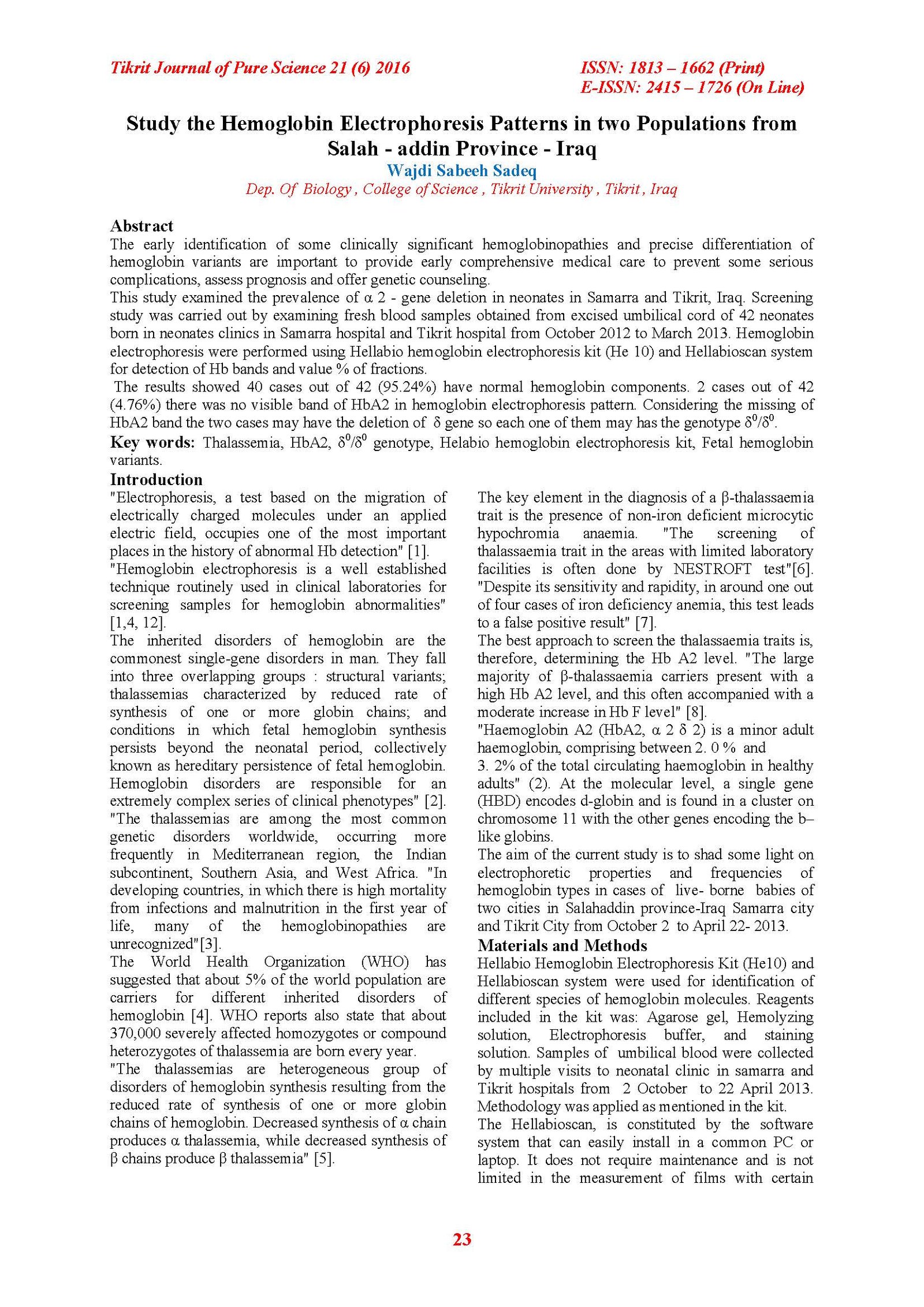Study the Hemoglobin Electrophoresis Patterns in two Populations from Salah - addin Province - Iraq
Main Article Content
Abstract
The early identification of some clinically significant hemoglobinopathies and precise differentiation of hemoglobin variants are important to provide early comprehensive medical care to prevent some serious complications, assess prognosis and offer genetic counseling.
This study examined the prevalence of α 2 - gene deletion in neonates in Samarra and Tikrit, Iraq. Screening study was carried out by examining fresh blood samples obtained from excised umbilical cord of 42 neonates born in neonates clinics in Samarra hospital and Tikrit hospital from October 2012 to March 2013. Hemoglobin electrophoresis were performed using Hellabio hemoglobin electrophoresis kit (He 10) and Hellabioscan system for detection of Hb bands and value % of fractions.
The results showed 40 cases out of 42 (95.24%) have normal hemoglobin components. 2 cases out of 42 (4.76%) there was no visible band of HbA2 in hemoglobin electrophoresis pattern. Considering the missing of HbA2 band the two cases may have the deletion of δ gene so each one of them may has the genotype δ0/δ0.
Article Details

This work is licensed under a Creative Commons Attribution 4.0 International License.
Tikrit Journal of Pure Science is licensed under the Creative Commons Attribution 4.0 International License, which allows users to copy, create extracts, abstracts, and new works from the article, alter and revise the article, and make commercial use of the article (including reuse and/or resale of the article by commercial entities), provided the user gives appropriate credit (with a link to the formal publication through the relevant DOI), provides a link to the license, indicates if changes were made, and the licensor is not represented as endorsing the use made of the work. The authors hold the copyright for their published work on the Tikrit J. Pure Sci. website, while Tikrit J. Pure Sci. is responsible for appreciate citation of their work, which is released under CC-BY-4.0, enabling the unrestricted use, distribution, and reproduction of an article in any medium, provided that the original work is properly cited.
References
[1] Henri Wajcman and Kamran Moradkhani (2011) Abnormal haemoglobins: detection and characterization. Indian J Med Res 134; pp 538-546.
[2] Weatherall DJ, Clegg TB, Higgs DR, Wood WG. The hemoglobinopathies. In : Scriver CR, Beaudet AL, Sly WS, Valle D (Eds.), (2001) The Metabolic and Molecular Bases of Inherited Diseases, 8th Edition. New York: McGraw Hill; 4571-4636.
[3] Shivashankara A.R, Jailkhanir, Kini A. (2008) Hemoglobinopathies in Dharwad, North Karnataka: A Hospital- Based Study. Journal of Clinical and Diagnostic Research ; (2)593-599
[4] Angastinosis M, Modell B. (1998) Global epidemiology of hemoglobin disorders. Proc Natl Acad Sci USA; 850: 251.
[5] Singh SP, Gupta SC.(2008) Effectiveness of red cell osmotic fragility test with varying degrees of saline concentration in detecting beta-thalassaemia trait. Singapore Med J ; 49 : 823-6.
[6] Bobhate SK, Gaikwad ST, Bhaledrao T. (2002) NESTROFF as a 6. screening test for detection of Beta-thalassaemia trait. Indian J Pathol Microbiol; 45 : 265-7.
[7] Louahabi A, Philippe M, Lali S, Wallemacq P, Maisin D. (2006) Evaluation of a new Sebia kit for analysis of haemoglobin fractions and variants on the Capillary system. Clin Chem Lab Med 44 :340-5.
[8] Old JM. (2003) Screening and genetic diagnosis of hemoglobin disorders. Blood Rev; 17 : 43-53.
[9] Ida Bianco, Mria Pia Cappabianca, Enrica Foglietta, Mria Lerone, Giancarlo Deidda, LuigiI Morlupi, Paola Grisanti, Donatella Ponzini, Silvana Rinaldi, Bruno Graziani (1997) Silent Thalassemias: Genotypes and Phenotypes. Haematologica 82:269-280.
[10] Hadaviv, Taromchiah AH, Malekpour M, Gholamib, Law HY, Almadanin, Afroozan F, Sahebjame F, Pajouhp, Kariminejad R, Kariminejad MH, Azarkevivan A, Jafroodi M, Tamaddoni A, Puehringer H,Oberkanins C, Najmabadih. (2007) 0nElucidating the spectrum of alpha-thalassemia mutations in Iran. Haematologica; 92: 992-993.
[11] Lacerra G, Scarano C, Lagona LF, Testa R, Caruso DG, Medulla E, et al. (2010) Genotype-phenotype relationship of the δ-thalassaemia and Hb A(2) variants: observation of 52 genotypes. Hemoglobin; 34 : 407-23.
[12] Giambona A, Passarello C, Renda D, Maggio A. (2009) The significance of the haemoglobin A(2) value in screening for haemoglobinopathies. Clin Biochem; 42 : 1786-96.
[13] Vichinsky E. (2007) Hemoglobin E syndromes. 29. Hematology Am Soc Hematol Educ Program;. p. 79-83.
[14] Codrington, J.F., Li, H.-W., Kutlar, F., Gu, L.-H., Ramachandran, M. & Huisman, T.H.J. (1990) Observations on the levels of Hb A2 in patients with different b-thalassemia mutations and a d chain variant. Blood, 76, 1246–1249.
[15] Rund D, Fucharoen S. (2008) Genetic modifiers in hemoglobinopathies. 31. Curr Mol Med; 8 : 600-8.
[16] Steinberg, M.H. & Nagel, R.L. (2009) Hemoglobins of the embryo, fetus, and adult. In: Disorders of Hemoglobin: Genetics, Pathophysiology, and Clinical Management, 2nd edn (ed. by M.H. Steinberg, B.G. Forget, D.R. Higgs & D.J. Weatherall), pp. 119–135. Cambridge University Press, New York, USA.
[17] Genetics Committee of the Society of Obstetricians and Gynaecologists of Canada (SOGC) (2008) Carrier Screening for Thalassemia and Hemoglobinopathies in Canada. Clinical Practic Guid Lines No. 218. Wood WG. Hemoglobin synthesis during human fetal development. Br Med Bull, 1976; 32 (3): 282-287.
[19] The Virginia Sickle Cell Awareness Program: A Counseling Guide for Sickle Cell and Other Hemoglobin Variants. Division of Women’s and Infant’s Health, 109 Governor Street, Richmond, Virginia 23219. www.vahealth.org/sicklecell/
[20] Abdulrahaman A Momin, Mangesh P Bankar, Gouri M Bhoite (2012) The prevalence of α Thalassemia in South Western Maharashtra. Biomedical Research 23 (1): 152-154
